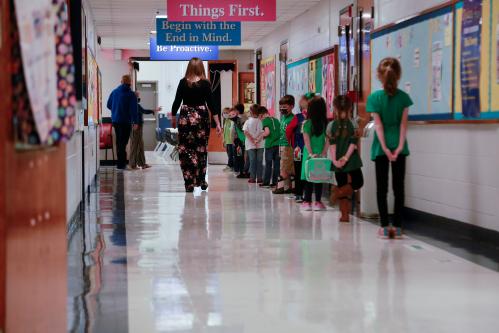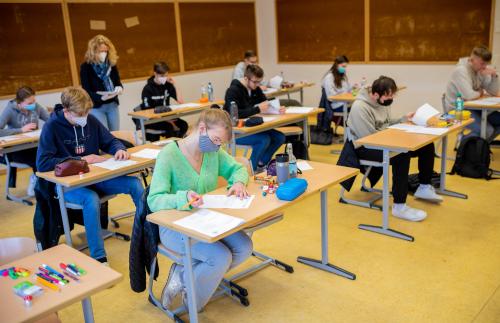Parent preferences for how their children attended school throughout the pandemic have been disparate. Many polls and media reports have tracked the differences in parent preference for in-person versus remote learning, including USC Dornsife’s Understanding America Study (UAS).
Our most recent UAS data, collected from 1,510 K-12 parents between mid-April and the end of May, shows sizable gaps along racial and ethnic lines, with 19% of white parents currently preferring fully remote instruction compared to 43% of Black and 42% of Hispanic families. Similarly large gaps by household income are also evident. Despite progress on vaccines and rapidly diminishing case rates, stark differences by race and income in preference for remote versus in-person attendance persist.
For most children, in-person education is higher quality than remote, with academic progress and mental health stymied through remote education. School systems were not prepared to offer high-quality remote instruction, even less to offer high-quality in-person and remote instruction simultaneously. And while educators have worked harder than ever during the pandemic, including to meet the emotional and other needs of their students, children need to come back to school. Even the president of the American Federation of Teachers, Randi Weingarten—who ardently fought for teachers to be allowed to teach remotely during the 2020-21 school year—now supports full-time in-person instruction in 2021-22.
To date, researchers and journalists have attempted to identify driving reasons behind keeping students at home. Some have concluded, using UAS data collected prior to our present April/May 2021 administration, that parents did not send their children back in part or primarily because their children’s schools were not open. Others, also using earlier UAS data, placed more emphasis on lack of trust in schools that had not provided children with a strong education before the pandemic, fears of COVID-19, and dilapidated school buildings. To help sort out these competing theories, in the latest round of UAS data collection we simply asked parents with remote children directly: “What are the reasons for why your child is currently remote?”
As the survey was administered, in April and May 2021, nearly 50% of the adult population had received at least one vaccine, and the FDA first approved vaccines (Pfizer) for children 12-16 years of age, making all indoor spaces safer—including schools. Yet still 30% of the UAS sample responding during this period reported their child was attending school fully remotely. Despite the hypothesis that a primary driver of remote attendance was that schools were not providing an in-person option, only 10% reported that the reason their child was currently remote was because their child’s school had no in-person option at the time they responded.
Figure 1 below shows the most commonly selected reasons for the child attending remotely from a list of potential answers provided. Almost half of respondents selected the option that remote learning was safer. Almost one-third indicated their child wanted to stay remote. Meaningful numbers of parents (22% and 25%) responded that the child was the same/happier or that the child was the same/better academically. Less frequent were concerns about the lack of comfort/flexibility of COVID-19 mitigation strategies, that adults in schools were not vaccinated, or that a hybrid schedule was the only option.
Because respondents could indicate multiple reasons, we analyzed patterns of response across all items. (Methodological details available upon request.) We found three dominant types of response patterns:
- those selecting reasons related to what we labeled “child fit” (such as my child is happy at home or my child is doing just as well at home), but not safety (27% of respondents)
- those selecting reasons related to safety but not “fit” (28%)
- those selecting both safety and “fit” reasons (33%).
Twelve percent of respondents provided a pattern of response that did not fall into any of these patterns.
What does all this mean for the 2021-22 school year? Across all responding parents (n=1,510, the full parent sample), 9.5% reported they plan to continue with remote education in the fall and 13.5% are unsure about sending their child to in-person learning. Stated another way, a full 23% of families expressed either tentative or concrete plans to keep their children learning remotely in the fall.
Furthermore, the sheer level of school hesitancy among some subgroups is worthy of immediate attention. As shown below, almost 40% of Black families and more than one-quarter of Hispanic families are expressing hesitation about sending their children back to school in the fall, significantly higher proportions than white families. Nearly 20% of Black families report they are not planning to send their children back, with another 20% unsure. Lower-income groups and those with less-formal education also prefer to continue remote education at higher rates.
Table 1: Percentages of K-12 parents planning for their child to learn remotely at the beginning of the 2021-22 school year
| Race/ethnicity | Remote | Unsure | Remote plus unsure |
|---|---|---|---|
| Asian | 5.8% | 7.1% | 12.9% |
| White | 7.8% | 9.1% | 16.9% |
| Hispanic | 8.5% | 19.2% | 27.7% |
| Black | 19.6% | 18.5% | 38.1% |
| Overall | 9.5% | 13.5% | 23% |
Within each of the three groups of parents who kept their children home in April-May—those keeping students home for “fit” versus safety versus both reasons—about half plan to continue to keep their child home in the fall or are unsure. This rate is about five times more than that observed among parents with children currently learning in-person, of whom 9% plan for their child to learn remotely or are unsure of the mode for next school year.
These results have two primary implications. First, schools need to be clearly communicating and consistently reaching out to families about local school safety precautions, virus caseloads, and vaccination rates among teachers and students. Parents’ understanding of local school success with COVID-19 mitigation strategies, low case incidences, and lack of disease spread in schools over time could help them gain confidence in the safety of in-person learning. This means school leaders themselves must feel their schools are safe, and districts must carefully track and regularly share with parents data describing each school’s virus caseload and vaccination rates.
Second, if online options are offered, families will take them, and more so from disadvantaged groups. If districts offer the option, it must be high quality, which it generally was not in 2020-21. Districts considering extending remote education in the fall must act upon lessons learned through pandemic school closures, and ideally join forces with other districts so each of the 13,000 U.S. districts don’t need to reinvent the wheel themselves. For example, if schools are going to continue offering a remote option, some teachers should teach exclusively online to students who attend exclusively online, allowing all teachers of both settings to be fully focused on one learning model. Students choosing to attend in-person schooling should be able to attend fully in-person–on a full-time schedule and with in-person teachers.
Districts will need to do the hard work of making the fully remote educational approach equal in quality and rigor to in-person settings along dimensions of academics, social-emotional, mental health, and physical health. And this work must be funded to ensure that the quality of the in-person education setting is not compromised. This hard work will require districts to dedicate American Rescue Plan funding as well as investment in research and development around effective strategies for fully remote education.
We gratefully acknowledge financial support from the National Science Foundation Grants No.2037179 and 2120194. Any opinions, findings, and conclusions or recommendations expressed in this material are those of the author(s) and do not necessarily reflect the views of the National Science Foundation. We are also grateful to Morgan Polikoff, Marshall Garland, Shira Korn Haderlein, and the UAS administration team for their contributions to this work.








Commentary
Why some parents are sticking with remote learning—even as schools reopen
June 8, 2021